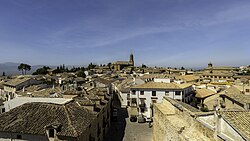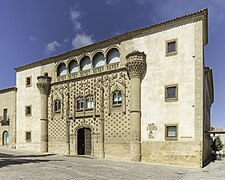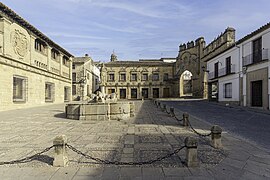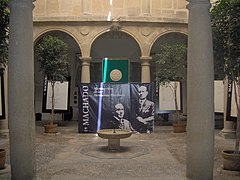Baeza, Spain
Baeza | ||
|---|---|---|
 Skyline, with the Cathedral at the centre. | ||
|
Postal code 23440 | ||
| Website | Official website | |
| Part of | Renaissance Monumental Ensembles of Úbeda and Baeza | |
| Criteria | Cultural: (ii), (iv) | |
| Reference | 522rev-002 | |
| Inscription | 2003 (27th Session) | |
| Area | 4.8 ha (12 acres) | |
| Buffer zone | 176 ha (430 acres) | |
Baeza. The present name was established in Roman times as Vivatia, then Biatia by the Visigoths, Bayyasa by the Moors from the 8th century onwards; until it became Baeza.
It is now principally famed for having some of the best-preserved examples of
Geography
The town lies perched on a cliff in the range (the Loma de Úbeda) separating the
History
The town stands at a high elevation about 3 miles (4.8 km) from the right bank of the
The Christian diocese was reestablished in 1127 or 1147[
For the rest of the middle ages, Baeza remained together with
The most important crops were those of cereal,[6] complemented by the likes of grapevines, olive, and almond.[7] Olive crops, far from the current-day olive monoculture, suffered from the mid-fifteenth century onward due to the cultivation of sumac.[6]
The diocese of Baeza was merged with
By the early 16th century, the jurisdiction of Baeza extended beyond the city proper to the hamlets of Begíjar, Lupión, Ibros, Rus, Vílchez, Bailén, Baños, Linares and Castro.[7]
The sixteenth century was the golden era of Baeza (and nearby
Landmarks


Baeza still houses several fine public buildings:
- St Michaelwas added in 1560.
- Town Hall (Ayuntamiento), a Plateresque building originally built as a combined courthouse and prison, leading to two separate main entrances
- Baeza University, established in 1533[4] or 1538,[citation needed] now a secondary school
- Santa Cruz Church, a Visigothicarch.
- St Paul's Church, a Gothic church with a Renaissance portal with a two-aisle nave and Gothic chapels. Includes the tomb of Pablo de Olavide.
- The Chapel of St Francis, in the ruins of a Renaissance building from 1538 formerly used as a monastery[2]
- Jabalquinto Palace (Palacio de Jabalquinto), including an Gothic entrance flanked by two cylindrical pilasters with Plateresque capitals with mocárabesornamentation, a Renaissance courtyard, and a Baroque staircase
- Spain Plaza (Plaza de España)
- Constitution Plaza (Plaza or Paseo de la Constitucíon), including a Caryatides[4]
- St Mary Fountain (1564)
- The Fountain of the Lions, from the Ibero-Roman ruins of Cástulo and possibly representing Himilce, wife of the Carthaginian general Hannibal
- The Úbeda Gate and Jaén[4] Gate.
- The Villalar Arch (Arco de Villalar), erected for Charles V's 1526 visit to honor his 1521 victory at Villalar.
- Seminary St Philip Neri[4](1660)
Transport
Baeza is 327 km (203 mi) south of
Notable locals
- Saro of Baeza, (c. 862) bishop
- Domingo of Baeza, (1236–1249), bishop Maroccofrom 1225 – 1236
- St John of Ávila (1499–1569), Christian mystic.[9][10]
- Gaspar Becerra (1520–1568), sculptor and painter.[11]
- St John of the Cross (1542–1591), Christian mystic.[12]
- Ginés Martínez de Aranda, (Spanish Wiki) (1556-1620), designer of the Fountain of Mary in the square of Baeza. He also contributed to some of the works of the Cathedral of Baeza.
- Pablo de Olavide (1725–1803), politician, lawyer and writer.[13][14]
- Antonio Machado (1875–1939), modernist poet, wrote Juan de Mairena inspired by his time in Baeza (1912–1919)
International relations
Baeza is
 Carcassonne, France[15]
Carcassonne, France[15]
Gallery
-
Palacio de Jabalquinto
-
Iglesia de la Santa Cruz
-
Iglesia de San Pablo
-
Plaza del Pópulo
-
Fuente de Santa Maria
-
Ayuntamiento
-
Council Seminary cloister, from Antonio Machado headquarter of International University of Andalusia
-
Santa María fountain and cathedral of Baeza
See also
References
- Notes
- Citations
- ^ Municipal Register of Spain 2018. National Statistics Institute.
- ^ a b c d e EB (1911).
- ^ "Paisaje de Úbeda y Baeza" (PDF). Instituto Andaluz del Patrimonio Histórico. p. 5–6.
- ^ a b c d e f g h i EB (1878).
- ^ Argente del Castillo & Rodríguez Molina 1987, p. 324.
- ^ a b Argente del Castillo & Rodríguez Molina 1987, p. 328.
- ^ a b Argente del Castillo & Rodríguez Molina 1987, p. 327.
- ^ Annuario Pontificio (in Latin), 2013, p. 847
- Diócesis de Jaén(in Spanish). 14 May 2009. Retrieved 29 September 2019.
- ^ "San Juan de Ávila, más de cerca en Baeza". Diario Jaén (in Spanish). 18 July 2019. Retrieved 29 September 2019.
- ^ Rodríguez Rebollo, Ángel. "Gaspar Becerra". Diccionario biográfico español (in Spanish). Real Academia de la Historia. Archived from the original on 28 September 2019. Retrieved 29 September 2019.
- Dialnet.
- Universidad de Sevilla(in Spanish). Retrieved 29 September 2019.
- Universidad Pablo de Olavide(in Spanish). Retrieved 29 September 2019.
- ^ La Dépêche Du Midi. "Carcassonne se trouve une jumelle" (in French). Retrieved June 26, 2012.
Sources and external links
- Official site for the municipal government
- "Renaissance Monumental Ensembles of Úbeda and Baeza", World Heritage Sites, UNESCO
- Ubeda and Baeza site Archived 2013-07-11 at the Wayback Machine
- Baeza, Spanish Ministry of Education, Culture and Sport
- "Baeza", GigaCatholic
- Romanesque church at Baeza
- Image Gallery of Baeza
- Baeza eGuide
- ebaeza.com eBaeza guide
Bibliography
- Argente del Castillo, Carmen; Rodríguez Molina, José (1987). "La ciudad de Baeza a través de sus ordenanzas". En la España Medieval (10). Madrid: ISSN 0214-3038.
- Baynes, T. S., ed. (1878), , Encyclopædia Britannica, vol. 3 (9th ed.), New York: Charles Scribner's Sons, p. 229
- Chisholm, Hugh, ed. (1911), , Encyclopædia Britannica, vol. 3 (11th ed.), Cambridge University Press, p. 191









